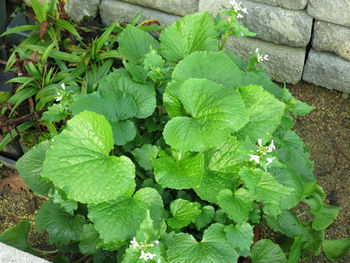Wasabi
Other Names : Eutrema japonicum, Wasabia japonica, Japanese Horseradish, Namida, Bergstockrose, ワサビ, わさび, 山葵, Japanischer Meerrettich, Wassermeerrettich
Allyl isothiocyanate is the ingredient in wasabi that is responsible for its strong odor. Wasabi's unique taste comes from other isothiocyanate compounds which are created by reactions between cells of the rhizome, which for wasabi are on the plant's long stem. When the cells are burst, such as due to eating or crushing, a reaction occurs between different components within different cells in the stem. These components are normally kept separate by the cell walls, so the taste isothiocyanate compounds are not present within the plant unless damage occurs to the stem to burst the cells and allow the chemicals to mix and therefore react. The reaction to produce the isothiocyanates is between rhizome thioglucosides (which are compounds containing glucose sugar and sulfur, also known as thiol) and water. This hydrolysis reaction is catalyzed by the enzyme myrosinase and only occurs when the enzyme is released as cells burst. The production of these isothiocyanates is therefore a defence mechanism by the plant to discourage animals from eating it. We Humans are a strange species as we actually seek out these pungent tastes! Lots of plants have a similar defence mechanism of pungent tastes produced when cells are damaged, and many of these chemicals have health benefits to humans as they are designed to react with the creatures eating them, namely other mammals.
See also :
Special Precautions of Wasabi
Due to its liver and gallbladder stimulating effects, eating wasabi may cause gastrointestinal disturbances, including diarrhea and nausea.
Benefits and uses of Wasabi are
Every part of the wasabi plant is used to promote health and well-being.
- Its leaves and stems are ground into antibacterial medicines, which aid in the treatment of respiratory problems like a cough, cold or sinus pressure.
- Can also be used to treat diarrhea, stimulate the appetite and remove toxins from the body.
- Wasabi is well-known for its strong antioxidant and digestive stimulant properties and can be used to promote overall wellness and not just the treatment of illnesses and disease symptoms.
- The most well-known use of wasabi for medical purposes is to clear clogged sinuses. Since the odor of the wasabi is so powerful, it takes only a few seconds of inhaling the scent for the nasal passages to clear and allow the person the ability to breathe normally again. However, if too much wasabi is inhaled, it can cause burning and pain on the inside of the nasal cavity.
- certain plants materials in the wasabi can be given to patients to prevent the formation of blood clots.
- Cancer : it is thought that some of the substances within the plant can prevent the growth of human cancer cells found in the lining of the stomach.
